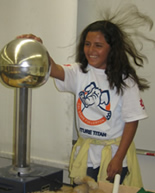Sixth-Graders Are
Going to College This Spring
Campus Tours Include Visits to Science Labs to
Conduct Experiments
April 20, 2007 :: No. 179
During their recent visit to campus,
more than 240 sixth-graders from Anaheim and Garden Grove
schools experienced what it’s
like to go to college at Cal State Fullerton. Beginning Monday,
many more youngsters are expected on campus in the coming
weeks as participants in the Kids to College program.
Students from Anaheim’s Palm Lane Elementary School
and Hazard and Riverdale elementary schools in Garden Grove
toured the campus, participated in various science labs in
the College of Natural Sciences and Mathematics, and met
with faculty, staff and students. For most, it was their
first visit to a university.
Biochemistry major Kristina Morey, a research student in
chemical education who plans to become a high school chemistry
teacher, helped the students with a hands-on experiment.
The students obtained samples in order to describe the physical
and chemical properties of four powders. Using this data,
they then determined the identity of an unknown powder.
“It’s a great inquiry-based activity that gave students experience
with different aspects of doing science — from developing theories and
describing evidence, to safe practices when handling chemicals,” said
Kereen Monteyne, assistant professor of chemistry and biochemistry who coordinated
the lab experiment.
The students’ field trip to the university was made
possible through the Kids to College program, a collaboration
between the Tomás Rivera Policy Institute, a nonprofit
policy research organization; the Sallie Mae Fund; and the
California State University Chancellor’s Office. The
Sallie Mae Fund contributes $25,000 a year to the three-year
program, which gives students and families in underserved
communities information on the pathway to college, including
financial aid options.
“Kids to College serves as a launching program toward college exploration
for sixth-graders in the local school districts surrounding Cal State
Fullerton,” said Mark Kamimura-Jimenez, the university’s director
of educational partnerships.
The goal of the program is to serve a total of 3,700 students,
he said. This spring, the second year of the pilot program,
an estimated 3,200 elementary students will have the opportunity
to learn about college, how to prepare for a higher education
and what to expect when attending a university such as Cal
State Fullerton. Last year, about 1,200 students participated
in Kids to College.
“We expect to surpass our goal, due to the overwhelming interest from
local school districts,” Kamimura-Jimenez said. “More than 5,200
students from 17 schools in the Anaheim, Fullerton, Garden Grove and Santa
Ana school districts are expected to be served over the three-year program.”
Students from other local schools will visit Cal State Fullerton
as part of the Kids to College program during the coming
weeks: April 23, Sunkist, Abraham Lincoln
and Francis Scott Key elementary schools, Anaheim; April
25, Palm Lane Elementary School, Anaheim; April
27, Willard and Carr intermediate schools, Santa
Ana; and May 25, Francis Scott Key Elementary
School, Anaheim.
As part of the program, teachers attend workshops and learn
a curriculum that helps them teach their students about college
life before arriving on campus. The curriculum provides teachers
with information and activities on preparing for a college
education, including teaching students such university-related
vocabulary as “degree,” “higher education” and “college
requirements.”
When students visit the campus, they meet Cal State Fullerton
staff members who tell them about the benefits of getting
a college education, as well as answer their questions.
“No longer is college an option, but a must,” University Outreach
counselor Brenda Gamez told sixth-grade students from McFadden Intermediate
School in Santa Ana.
Gamez added that young students are the future of this country,
and they need to be well-prepared in order to have a better
future.
“As educators, we need to instill in them the passion for education and
teach them different ways to get there,” she said.
Roberto Gonzalez, director of the university’s Upward
Bound program, which is
designed to prepare underserved high school students for
postsecondary education, also stressed
the importance of programs that expose young students to college.
“The earlier we get the message out to young students about pursuing
a college degree, the better,” he said.
Gonzalez also gave a talk to the Santa Ana students, who
asked him such questions as “How many years does it
take to earn a doctorate?” “Did you live in a
dorm when you went to college?” and “Why did
you choose the colleges you attended?”
“I always tell them that college is affordable and doable,” said
Gonzalez, who is pursuing a doctorate in education from USC.
Gonzalez, who grew up in Santa Ana and whose high school
counselor told
him that he “wouldn’t amount to anything,” told
the young students not to
listen to others, but rather follow their own dreams: “You
make the choice about whether you are going to college.”
Photos: Available at www.fullerton.edu/newsphotos
| Media Contacts: |
Mark Kamimura-Jimenez, Educational Partnerships,
657-278-5579 or mkamimura-jimenez@fullerton.edu
Debra Cano Ramos, Public Affairs, 657-278-4027 or dcanoramos@fullerton.edu |
«
back to News Front
|

Murtadha Khakoo, chair and professor
of physics, demonstrates the charging effect of a Van
der Graaf electrostatic generator to Kids to College
students who visited the College of Natural Sciences
and Mathematics. As a result of the high electric field
between the sixth-grader and her surroundings, there
is a force of attraction that causes the student’s
hair to stand on end.
 download image
download image
|
| Get Expert Opinions On... |
|
 |
| |
|